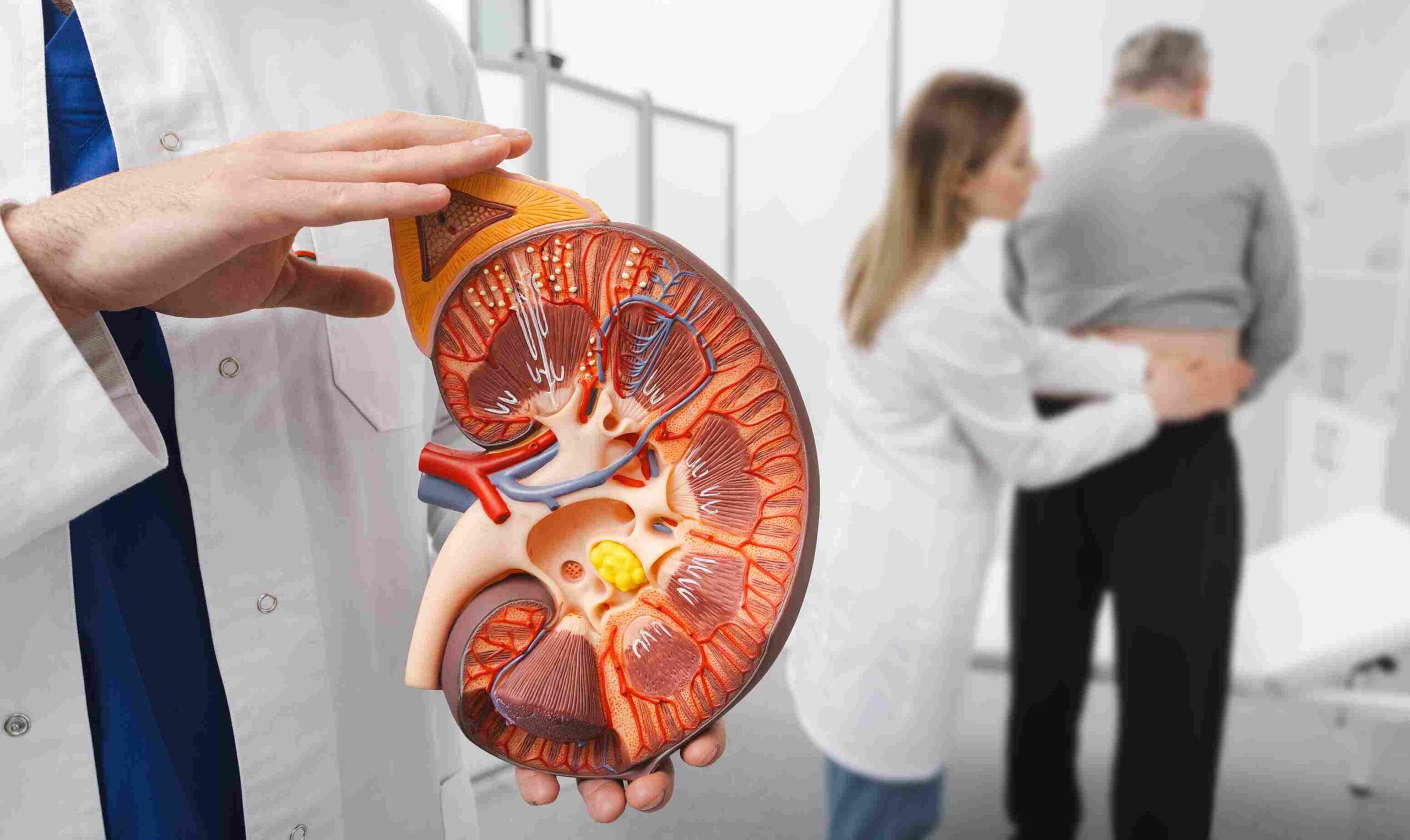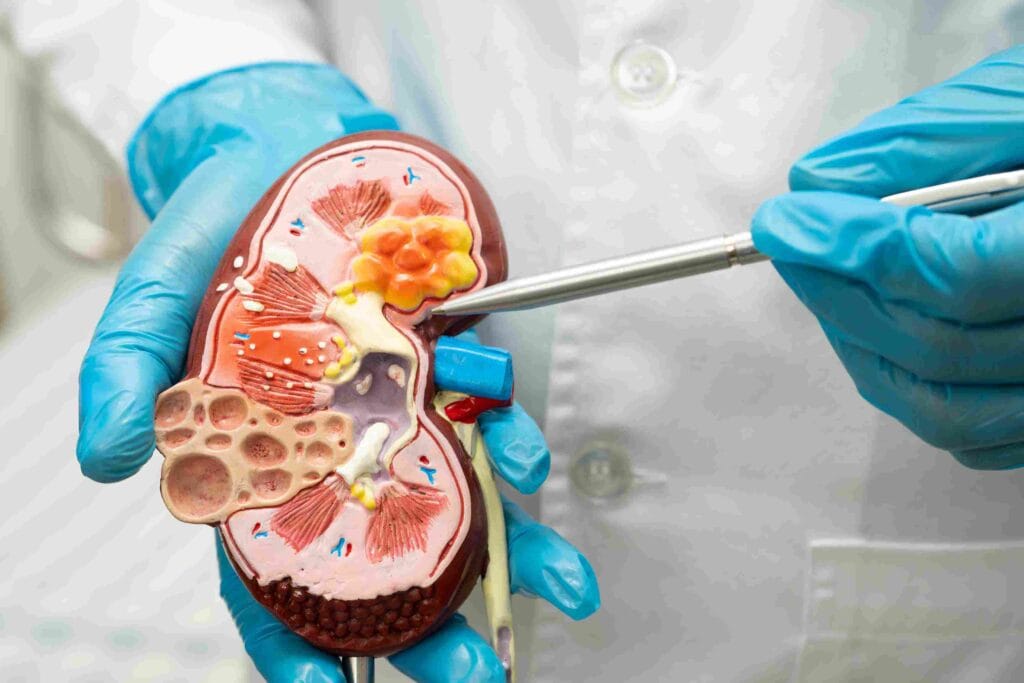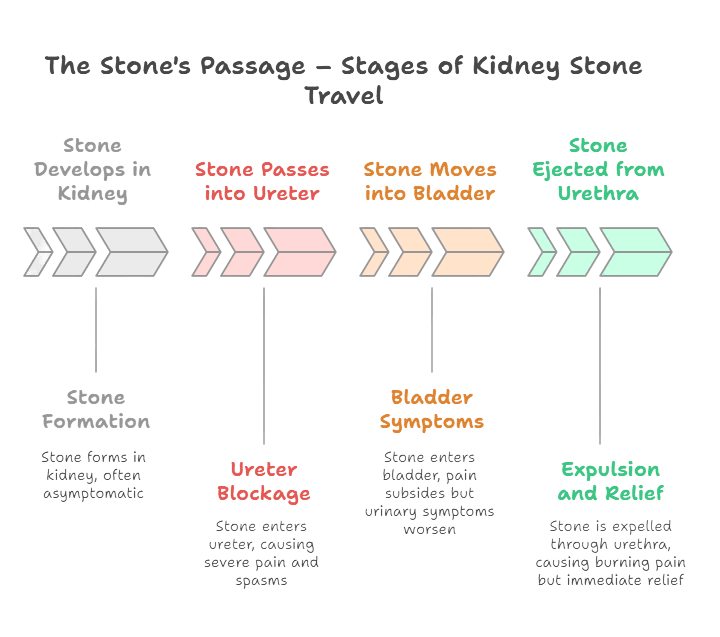
Table of Contents
Introduction
Stages of passing a kidney stone — Just reading those words may make you wince. If you have ever had that piercing, spreading pain, you know it’s not something anyone ever forgets. That sudden pain in your lower back or side, one so intense that you can’t even stand up straight, much less walk or take the stairs, may be a sign you’re passing a kidney stone.People describe the pain of passing a kidney stone as “excruciating,” often putting them on a par with childbirth.
The pain can be all too real but guess what: knowing why it hurts and what comes next makes a world of difference. The more you understand of these stages, the better equipped you are to manage them. And, perhaps most importantly, being aware of what causes kidney stones can help you prevent them altogether down the line.
That’s precisely why we created this guide.
Well, we’re going deep inside the actual stages of passing a kidney stone — none of the gobbledygook in the clinical textbooks, the things that are never discussed or glossed over. From your first twinge of shock to the final stage no one expects (yes, #5 really will shock you), this is your source – your go-to guide. We’ll parse symptoms, how they move through your system, treatment methods, emergency red flags and smart prevention strategies grounded in the science.
So whether you’re in the throes of an attack, caring for another cluster headache sufferer or just want to do whatever it takes to make sure you (or your loved one) never have to go through this again — read on. Relief, understanding and actual help begin here.
#1. What Are Kidney Stones, Exactly?
Kidney stones, also known as renal calculi, are hard, solid masses which are developed in kidneys or urinary tract. They form when minerals, waste products and other materials in the urine crystallize and stick together. They can be as small as the grain of a sand and pass unnoticed or large and in need of treatment due to pain.
Types of Kidney Stones
Kidney stones can be categorized into four major types, depending on their origin and nature:
- Calcium Stones – Most prevalent, composed of calcium oxalate or calcium phosphate. They arise when the urine contains too much calcium.
- Cystine Stones: Rare in occurrence, they are a result of a genetic condition called cystinuria (leakage of amino acid cystine into the urine and crystallize).
- Struvite Stones: These stones are commonly the result of a urinary tract infection (UTI), and are made of magnesium, ammonium, and phospate.
- Uric Acid Stones: These develop when there’s too much uric acid in the urine, which can occur due to a high-protein diet, dehydration, or certain health conditions such as gout.
How Do Kidney Stones Form?
Your kidneys accumulate waste products that can’t be dissolved properly in your urine — so you accumulate crystals. This often occurs when you’re not drinking enough water, which creates overly concentrated urine. When you don’t have enough fluid to dilute these waste products, they crystalize, and eventually stick together to create a stone. The more concentrated your urine, the greater the risk of stones.
These essential truths are the foundation for comprehending what actually happens when you pass a kidney stone and how to avoid them in the future. Let’s see what happens next when these stones are set in motion!
#2. Identifying the Symptoms – The Most Common Symptoms of Kidney Stones
“The hallmark sign of passing a kidney stone is abdominal or flank pain, which can be quite severe and cause intense and sharp stabbing pain,” explains Leon Boudourakis, MD, a urologist at St. Francis Hospital of Roslyn in Roslyn, New York. This pain may hit in intervals and can climb quickly in just a couple of seconds from a mild, agonizing feel to intense, barely tolerable pain. According to the American Urological Association, this is one of the most frequent reasons for people to seek emergency medical care in the U.S.
Where Does the Pain Occur?
The pain usually appears in the back or the side, below the ribs. The bottom line As the stone travels downward toward the bladder, the pain can escalate to the lower region of the abdomen and also to the groin. The site and the degree of the pain depends on the size and position of the stone (8-10). The seeds of the pain seem straightforward: The kidney’s blockage or attack can cause waves of cramping, sharp pain in what’s known as renal colic, a pain so intense it is often described as one of the most severe a person can experience.
Other Common Symptoms
In addition to being in such excruciating pain, other typical signs of kidney stones include the following:
- Painful urination: As the stone nears the bladder, you may feel a burning sensation when you urinate.
- Nausea and vomiting: The body’s reaction to extreme pain can cause nausea or, occasionally, vomiting. According to a study in The Journal of Urology, roughly 30% of kidney stones patients have vomiting caused by the severe pain.
- Fever or chills: If an infection occurs because the stone is blocking your urinary tract, it could cause a fever or chills. It’s also a potentially serious symptom, signaling a UTI or, in the worst case, a condition such as sepsis, which requires prompt medical care.
- Blood in urine: Red blood in the urine, or hematuria, is another common symptom, though it is not always visible to the naked eye.
Confusion with UTI Symptoms
And because a few of those symptoms, such as pain when you pee and nausea, overlap with those of a UTI, kidney stones are also sometimes mistaken for a UTI. Kidney stones are usually characterized by a more severe, wavering pain, while UTIs typically produce a more steady burning during urination.
Knowing which is which can make a big difference in finding the appropriate treatment quickly. Other conditions to rule out If you suspect kidney stones, make an appointment with your healthcare provider to rule out other possible causes.
#3. The Stone’s Passsage – Stages During Its Travel
Having a kidney stone is no picnic, but if they cause problems passing, this can be an intense situation. It’s a process that can last anywhere from a few days to several weeks, depending on the size of the stone and where it is located. Here is a look at a general pattern of the steps that are normally involved as the stone makes its way along the urinary tract.
Stage 1: The Stone Develops in the Kidney
At that point, the stone is still in the kidney, where it forms in the first place from crystals of waste products that include calcium or uric acid. Most people don’t have symptoms, so this stage is typically painless. But any mild discomfort or dull pain in the lower back is something that should be noticed, depending on the size of the stone.
Stage 2: Stone Passes into the Ureter
Now that the stone is no longer in the kidney, it is painfully entering into the ureter! As the stone passes down the ureter, it may block the flow of urine and cause the ureter to spasm, which can lead to extreme pain. This is when people can be tempted to look for emergency medical care. Symptoms may be intermittent and appear in waves and may occasionally radiate to the lower abdomen or groin.
Stage 3: Stone Moves into the Bladder
As the stone passes into the bladder, however, the pain may subside, but urinary symptoms may get worse. You can also feel like you have to pee more often than is comfortable and when you do urinate, it could be painful; you might have blood in your urine (hematuria). As the pain decreases the pressure from the stone settling in the bladder is enough to be disturbing to some some patients who find it hard totolerate.
Stage 4: The Stone is Ejected From the Urethra
At last, the stone is expelled from the body through the urethra, the tube that allows urine to flow from the bladder to the outside. This state is commonly rounded off by a sudden burning pain as the stone pass’ s. You may need to push firmly to help “push” out the stone, and it may be unpleasant and sting or burn. Relief is usually instantaneous after passing a stone, although you may experience some residual irritation.
These stages may not occur in a set order or at a predictable time; they may come in a different order, or one stage might be more intense and take longer than another. Knowing what happens during each stage will help you get through the pain of whatever being dumped may bring.
#4. How Long Will This Last? Influencing Factors of Passage Time
The number of days it takes to pass a kidney stone can be different depending on how long it takes for a stone to form. It takes some people only a few hours or a few days to do so, while with others it can take several weeks. By understanding the most important elements which impact passage time, you can better prepare so that you go through the process with greater ease and have a clearer idea of how long it’s going to take.
Key Predictions: Stone Size and Position
Two of the crucial factors that impact the time it takes to pass a kidney stone are the size and the location of the stone. Studies show both contribute to whether the stone will pass on its own or you need medical intervention.
Stone Size:
- Small stones ( <4 mm): These stones will most likely pass spantaneously, from 0 mm–3.4 mm there is a 98% long term passage rate.
- Medium stones (3.5–4.4 mm): They have an 81% chance of passing.
- Big Stones (≥4.5 mm): Big shout out to those of us with stones larger than 4.5 mm, as we have encountered 50/50 odds when it comes to getting this size to pass on its own:
- 5.5–6.4 mm: 33% passage rate
- ≥6.5 mm: Only 9 percent will pass without medical assistance.
Stone size and location are independent variables that influence the chances of spontaneous passage, according to the findings of a study published in The Journal of Urology.
Stone Location:
Passage time is also strongly influenced by the site, where the dam is situated. Stones near the lower ureter (distal ureter, for example, the ureterovesical junction) are far less likely to need further intervention and will often pass on their own.
- Lower stones: They are 4.5 times more likely to pass within the short term and 5.2 times more likely to pass in the long term than upper ureteric stones.
Similarly, stones located in the upper part of the ureter (closer to kidney) are more time expensive to pass and involve increased medical management.
Other Influencing Factors
Stone size and location are its most significant predictors, but a few other conditions can impact passage time:
- Hydronephrosis (swelling in the kidney caused by blockage): This does increase your short-term probability of passing a stone, but it is not a big player in longer-term outcomes.
- Stone side: Research suggests that left-sided stones move more easily than right-sided stones.
- Age, sex, and CRP: These have only a minor influence and no predictive value in passing according to the study.
Curiously, the thing that most of us who pass stones and then visit specialist advises to facilitate stone passage — Medical Expulsive Therapy (MET) also wasn’t a significant predictor in this study, although other research suggests that MET can help in some cases.
In summary, the length of time it takes for a stone to move is influenced by numerous factors, with size and location being the most critical. Knowing them can also help to create appropriate expectations and influence decisions about seeking medical care.
#5. When Urgent Medical Attention is Required – Realizing Kidney Stone Emergencies
Kidney stones are a pain in the (you know what), but sometimes they’re a true emergency. Symptoms can be severe and prompt medical attention is actually needed to avoid the long-term (or even fatal) effects of untreated complications. You need to know when to ask for help so that you don’t expose yourself to more significant risks.
Warning Signs of a Kidney Stone Emergency
If you have any of these symptoms, seek medical care right away:
1. Severe Pain That Cannot Be Controlled
Persistent and Severe Pain “The number one sign of a kidney stone is severe pain that wakes a person up in the middle of the night,” says Laura Blue, MD, a urologist with the Texas urology group, Urology San Antonio.
More severe pain, which cannot be relieved. As terrible as kidney stone pain sounds, you shouldn’t be running to urgent care a la Gronk unless your pain feels unmanageable with over-the-counter or prescription painkillers. If the pain becomes unbearable, or doesn’t go away after taking medication, that could indicate a more severe problem, like a stone causing a serious blockage in the urinary tract.
2. Fever and Chills
Fever and chills may indicate infection, which may result from a blocked urinary tract. When a stone interferes with the flow of urine, bacteria may grow in the urine, leading to a urinary tract infection (UTI). If not treated, this can progress to sepsis, a deadly condition that can lead to organ failure.
3. Nausea and Vomiting
Given that nausea and vomiting are symptoms when you have kidney stones, if you begin to throw up and can no longer hold down liquids or medication, that might be a sign of a more serious complication. Dehydration and the inability to drink fluids will make the condition worse, and delay stone passage.
4. Complete Inability to Urinate
If you absolutely can’t pee at all, that’s a serious issue that needs to be addressed as soon as possible. The obstruction may be the result of a stone, totally obstructing the urethra or urinary passage, so that urine cannot pass out of the body and eventually resulting in kidney injury.
5. Sudden, Significant Increase in Blood in the Urine
Some blood in the urine (hematuria) is fairly typical with the presence of kidney stones, but suddenly having a lot of blood, particularly when combined with intense pain, might be a sign that there’s a sizeable, complicated stone wreaking havoc. It may represent urinary tract pathology or the necessity for a surgical procedure.
Why These Are Emergencies
Complications of untreated kidney stones can be serious:
- Blockages: A stone that blocks the flow of urine can cause the kidney to swell (hydronephrosis), a problem that, if it isn’t relieved, can lead to long-term damage to the kidney.
- Infection and Sepsis – A clogged urinary tract can be conducive to bacteria growth so an infection and a blockage, the infection may spread to the blood stream infection which can be fatal if untreated promptly.
A study published in The British Journal of Urology International found that 20-30% of patients presenting with severe symptoms of kidney stones will develop infection or kidney injury as a result of delayed care.
And spotting these warning signs early, and getting appropriate medical care, could prevent life-threatening complications. If you develop any of these symptoms, don’t wait — seek emergency care immediately.
#6. How Kidney Stones Are Diagnosed
Whent you go to the doctor with symptoms of a kidney stone, the first part of a diagnosis is getting a complete medical history and discussion of your symptoms. Your doctor will inquire about the characteristics of your pain, prior episodes of kidney stones, diet, and fluid intake just to touch the surface. Knowing these specifics can help the doctor evaluate your risk and determine next steps.
Tests That Doctors Use to Diagnose the Disorder
1. Imaging Tests
Imaging tests are frequently used by doctors to determine if a kidney stone is present and its location. The following tests may be done to see the stone and find out how big it is and where it is located in the urinary system:
- CT scans: The most accurate and most common test, CT scans can rapidly identify stones of any size or location.
- Ultrasound: is a non-invasive alternative, it can be performed in pregnant patients or those in whom there is concern over radiation. Although effective, it might fail to detect smaller stones.
- X-rays: Now much less commonly used, plain X-rays can show some stones, but not all, and if the stones are made of materials that don’t show up on X-rays, X-rays will be of no help.
2. Urine Tests
Urine tests (urinalysis): Urinalysis can detect aspects such as:
- Blood in the urine (hematuria) is an indirect symptom that is fairly common with kidney stones.
- Crystals or other materials that can become stones.
- Signs of infection, possibly meaning UTI, or risk of sepsis.
3. Blood Tests
Blood tests can show kidney function and indicators of infection, such as an increased white blood cell count or C-reactive protein (CRP). These tests aid the doctor in evaluating whether the stone has resulted in kidney damage or an infection.
4. Analysis of Passed Stones
If you do pass a stone, capture and save it, so your doctor can have it tested. It is essential to analyze the stone in a laboratory as it enables chemical composition to be identified. This analysis also can determine the stone’s composition (calcium, uric acid, etc.), which along with a few tests can help doctors arrive at “what probably caused the stone,” said Dr. Stoller, including “what to do to prevent it.”
5. Genetic Testing
When there’s suspicion of inherited diseases that raise the risk of kidney stones, such as cystinuria or primary hyperoxaluria, doctors may suggest genetic testing to confirm a diagnosis and inform treatment choices.
With the aid of these diagnostic methods, physicians can make an accurate diagnosis for kidney stones, find the causes, and develop an appropriate management protocol for patients with kidney stones.

#7. Symptom Management and Treatment Considerations
The options available to treat a kidney stone depend on the size, location, and metabolic situation of the stone, as well as the presented symptoms and whether a complication such as hydronephrosis, hematuria, or infection is present. Less-invasive procedures are generally enough for small stones or for moderate pain. But in case of bigger stones or patients experiencing more severe symptoms, medical treatment would be required.
Management of Small Stones with Minimal Pain
For tiny ones, considered to be too small to pass on their own (and are normal <5 mm in diameter), the aim is more of aiding the symptoms and the pieces to get pushed through and passed naturally. Common strategies include:
1. Increased Fluid Intake
Staying well-hydrated is one of the best ways to flush a small stone through. ” More hydration can help to dilute the urine, which can make it easier for the stone to pass through your urinary tract. It’s recommended that the goal should be 2 to 3 liters of water intake per day (unless our health condition forbids that).
2. Pain Medication
Passing a stone can be painful, however, and sometimes over-the-counter pain relievers such as ibuprofen or acetaminophen can help with mild to moderate pain. In some extreme cases, physicians might be advised to use stronger pain medication to ease your pain while you go through the process.
3. Medical Expulsive Therapy (MET)
Doctors sometimes prescribe drugs such as the alpha-blocker. These drugs help to relax the muscles of the ureter, which can help the stone to pass. Alpha-blockers, such as tamsulosin, form the major class of drugs used in MET and have reduced ureteral spasm and increased the passage of stones. MET seems to improve the chances of spontaneous stone passage, particularly when stones are smaller than 10 mm [2].
Treatment for Larger or More Severe Stones
If the stones are big or if the stones causing much pain or other problems, aggressive treatment may be necessary:
1. ESWL (Extracorporeal Shock Wave Lithotripsy)
ESWL involves releasing shock waves into the body to break up the stone into smaller pieces that will eventually be passed out of the body in urine. It is less invasive and generally used for stones smaller than 2 cm.
2. Ureteroscope with Laser Lithotripsy
If the stone is obstructing or too large to pass on its own, doctors may perform a ureteroscopy with laser lithotripsy to break the stone into small pieces that can pass from your body or remove it altogether. A slim tube is placed into the ureter in order to see and remove the stone.
3. Surgery
On the rare occasion that other methods fail, surgery may be necessary to eliminate the stone. This is usually done for very large stones or when the stone is damaging the kidney.
With an understanding of the various treatments for kidney stones, you and your doctor can determine the right treatment for you based on the size, location and the severity of the kidney stone.
#8. Prevention of Future Stones – Personalized Care is Critical
Preventing recurrence of kidney stones is important, because most individuals who have had one experience at least 1 more within 7 years. With inadequate attention and the need for lifestyle changes, the chance of recurrences increases. Fortunately with these prevention approaches and strategies, you will also reduce the likelihood.
General Prevention Tips
While customized strategies will vary based on the type of stone you’ve had, there are general measures that may help prevent most kidney stones:
1. Stay Well-Hydrated
The No. 1 way to prevent kidney stones is to drink plenty of fluids. Being hydrated can help dilute urine and stop minerals from crystalizing. It is advised to have at least 2 to 3 liters of water per day to remain well hydrated and minimise the chances of stone formation.
2. Dietary Adjustments
Maintaining healthy eating that is balanced greatly encourages prevention. For most people, this means:
- Lower your sodium intake, because too much salt can lead to excessive calcium in your urine.
- Complete, or moderate your animal protein intake, specifically red meat which may lead to some form of stones.
- Eating more fruits and vegetables; which alkalinize the urine with this, reducing the acidic nature in the urine leading to non-formation of stones.
Individualized Prevention According to Stone Composition
Preventive strategies are more effective when they are adapted to the specific type of kidney stone you had. Here is how various stones call for different tactics:
1. Stones Calcium Oxalate (1) STILL A GOOD PAPER!
These are most common and with dietary changes can be prevented:
- Limit sodium, because it raises the amount of calcium in the urine.
- Limit animal protein to reduce the risk of calcium and oxalate that could collect as a deposit.
- Consume enough calcium rich food (not through supplements unless suggested by a doctor). Oxalate is bound by calcium in the gut, a process that lowers the chance of forming stones.
A clinical trial published in The New England Journal of Medicine found that a low-sodium, high-calcium diet lowered the risk of calcium oxalate kidney stones.
2. Uric Acid Stones
To help prevent uric acid stones, try to:
- Avoiding purine-rich foods, including red meat, shellfish and organ meats, which raise uric acid.
- Medications– Your healthcare provider may prescribe allopurinol to help lower the levels of uric acid in your blood and urine.
3. Struvite Stones
Struvite stones are commonly associated with urinary tract infections (UTIs). Here’s the way to avoid these stones:
- Acting on underlying UTIs, which can cause recurring infections that promote stone growth, Dussol added.
4. Cystine Stones
Cystine stones are rare and inherited genetically. The avoid strategy consists of:
- High-volume water intake in order to dilute the urine and prevent crystallization.
- Your doctor may also prescribe certain drugs to decrease cystine in the urine.
Final Thoughts
Prevention is most effective when it’s aimed at the type of kidney stone you’re prone to develop. Your doctor can help evaluate the best treatment for you, which might include dietary and lifestyle changes or medications. With some simple actions, you can even lower the risk of future kidney stones and bolster your general kidney health.
#9. Life After Passing a Stone
Journey With A Kidney That Has A Stone Passing a stone is good, of sorts, but appropriate recovery and follow-up care is essential in order to ensure a complete recovery and to avoid recurrence. Although the sharp pain can go away once the stone has left your body, your body does not immediately recover.
Recovery Period
If you’ve passed a stone, you may still experience some residual pain:
- Slight Smarting in Urethra.
- Urinate More Often or Feel an Urgent Need to Urinate as the Bladder Recovers.
- A dull ache as your body still rids itself of any remnants or scar tissue.
The symptoms tend to improve in a day or so, but it’s important to watch yourself. If your pain is persistent or if it worsens, it might be a sign of a complication, like an infection, or a blockage, that requires medical intervention.
Follow-Up Care
It is important to book a Follow-up With a Doctor after Passing a kidney stone. Depending on the size and how you passed the stone, your doctor might want to see if you are likely to pass another one on your own and if you would benefit from seeing an expert, such as a urologist or nephrologist (kidney doctor).
- A urologist will examine your urinary system for any defects or diseases that may have saved the stone.
- If you have concerns about kidney function, or a history of recurrent stones, a nephrologist can be involved.
Follow-up care may include:
- Urine tests to look for signs of infection or any particles left behind.
- Imaging for absence of remaining stones or of soon to form stones.
Adhering to the Plan of Prevention
Keep up your prevention plan Even after you’ve passed your stone. This may mean getting enough fluid, and modifying your diet and taking any particular advice that relates to the sort of stone you’ve had. If you have any medical conditions that could have made you more prone to developing stones, like hypercalciuria (high calcium levels in the urine) or gout, these can also up your chances of forming future stones. Working with your doctor to manage these conditions is a crucial part of preventing a repeat performance.
If you listen to your doctor and hold onto the habits that helped you prevent stones in the first place, you can lower the chance of future kidney stones and encourage long-term kidney health.
Experience relief with FemiPro! Our unique formula supports a healthy urinary microbiome, targeting harmful bacteria that cause unwanted leaks. Boost beneficial bacteria for better bladder control and improve urinary health today!

Conclusion
While a sufferer will tell you there is nothing funny when a kidney stone is passing, knowing the process and what treatment options are available to you may take some questions, and the sense of humor will come through. The more you know about the process of passing a kidney stone and what the symptoms might be, the more empowered you’ll feel to handle whatever comes your way, from the first little hint of pain to the time you finally pass the stone.
It is important to get medical attention early, whether for diagnosis, symptoms or, in case of warning signs such as severe pain, fever, or an inability to urinate. These are all red flags for a more serious problem, and, because intervention counts for a lot when complications show up on your doorstep.
Long term, prevention is everything. You can substantially reduce your risk of future stones by identifying the type of kidney stone you’ve passed by the stone analysis and developing a customized prevention plan. There are many ways to protect your kidney health, including making lifestyle changes and keeping your body well-hydrated. Simple changes—such as altering your diet and managing other ongoing health issues—can protect them and may even prevent a host of other problems.
By taking charge of your kidney health today, you can keep a healthier tomorrow. If you’d like to explore more ways to support your kidney function and overall well-being, feel free to check out this link. By taking proactive steps now, you’re investing in your long-term health and vitality.








This Post Has 3 Comments
The pain of kidney stones is something I’ve heard about but never fully understood until now. This guide breaks it down in such a clear way, especially the stages of passing a stone—I had no idea there were so many! The emphasis on prevention through hydration and understanding the science behind it is really helpful. I’m curious, though, how long does it typically take to pass a kidney stone once the symptoms start? Also, are there any specific foods or habits that significantly increase the risk of developing them? I’d love to hear more about the emergency red flags mentioned—what should someone absolutely not ignore? This guide feels like a must-read for anyone who’s experienced this or wants to avoid it. What’s your take on the most surprising part of the process?
The time it typically takes to pass a kidney stone varies based on size and location. Smaller stones (less than 4 mm) may pass in a few days, while larger stones (greater than 4.5 mm) can take several weeks or require medical intervention. Stone size and placement in the urinary tract are key factors in determining how long the process will take.
Yes, certain foods and habits can significantly increase the risk of developing kidney stones. High salt intake, excessive animal protein (especially red meat), and low fluid intake can contribute to stone formation. Additionally, foods rich in oxalate, such as spinach and nuts, may increase the risk for calcium oxalate stones. Staying hydrated and modifying your diet can help reduce the chances of stone formation.
Some emergency red flags for kidney stones that should not be ignored include severe, uncontrolled pain, fever or chills (indicating a possible infection), inability to urinate, significant blood in the urine, and nausea or vomiting that prevents you from holding down fluids or medication. These symptoms could signal serious complications like infection, sepsis, or complete urinary obstruction, which require immediate medical attention.